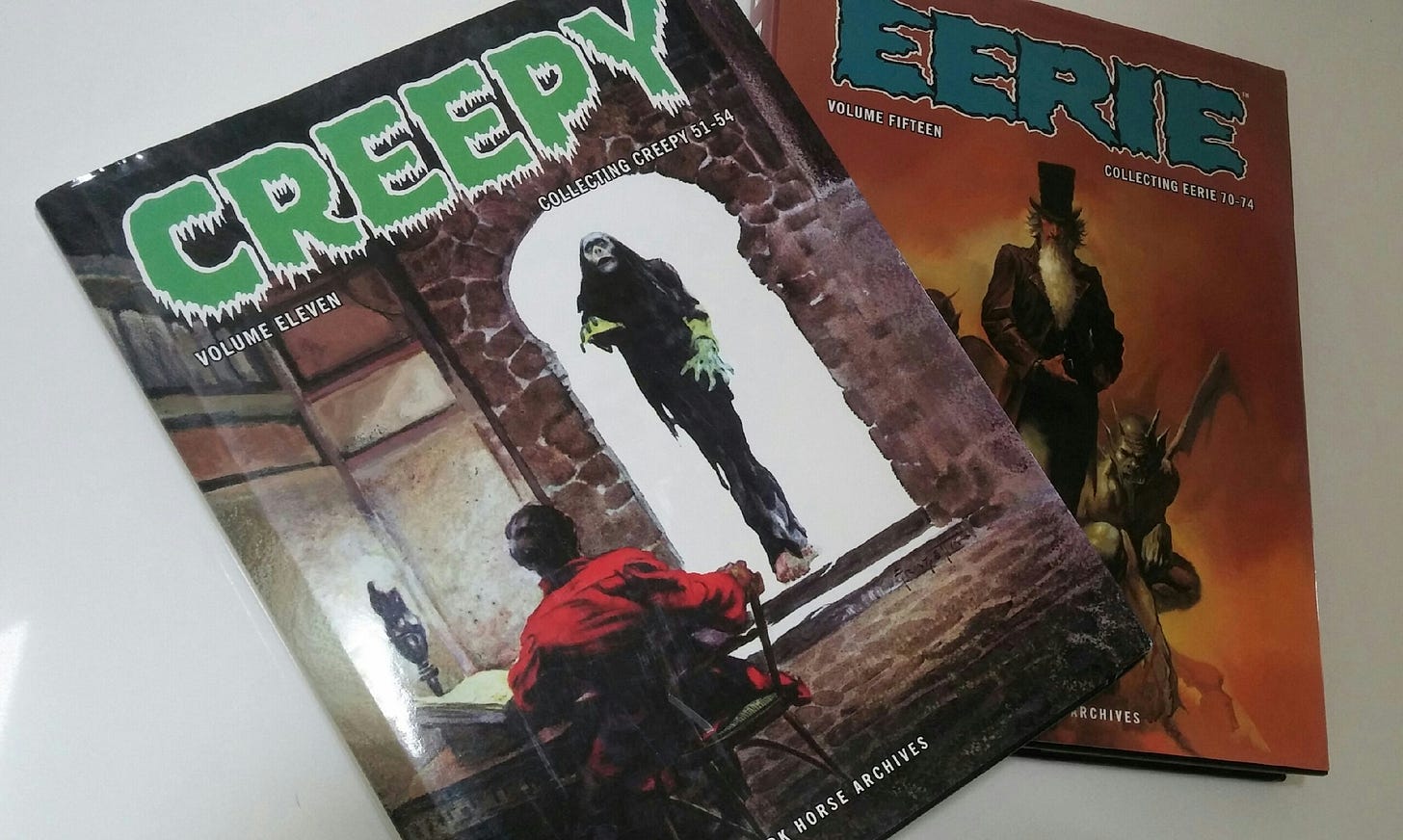You wonder why the meet cute scene in Fight Club takes place among terminally ill people? Stop wondering. You can blame it on EC Comics.
Consider that every ghost story is comforting.1 It demonstrates that an afterlife exists. People die, but they don’t. By their nature, ghost and horror stories are spiritual, and in many ways a demonstration of religion. Or at least morality.
In fact, in the world of EC Comics – which Dark Horse Founder Mike Richardson told me originally stood for Educational Comics – death can get you laid. At least that was the impression they made on the impressionable ten-year-old me. Eros and thanatos, two great tastes that taste great together. The Reese’s Peanut Butter Cup of sex and death. No comics held my attention like Tales from the Crypt or the less-shocking Ripley’s Believe It or Not! comic books2.3 4
In those pages lovers killed each other, then came back for revenge. Characters violated sacred ground. They laughed at curses and paid a hefty price. And it never failed, sex dripped from those pages.5 If a character was sexy at first, he was sexier once he’d stripped off his blood-drenched clothes in order to dig a deep grave in which to bury his murdered fiancé or boss or rich reclusive uncle. Naked grave digging looked like the best muscle building exercise ever. And if a victim was sexy, she came back from that grave with thick hair, luminous eyes and skin, and a smoke’n bod that wouldn’t quit. Death always did great things for the bust line.
Sex dripped from those pages.
As a pre-teen those comics made you yearn to grow up and have sex with either a psychotic murderer or a recently buried body. It was carnal and it was spiritual. It was magic. Sigh. It’s clear from my footnotes that these stories caused not lasting damage to my tiny brain.
Don’t even get me started on Wuthering Heights. Just because it soft pedals the ghost doesn’t mean it’s not a boffo ghost story of a guy haunted by a dead girl. Yeah, even if the girl was probably his half-sister. And if you believed old Earnshaw’s story that he “found” Heathcliff starving on the docks of Liverpool, I have a bridge to sell you. No, Earnshaw is clearly cast from the Bronte school of sleazy Mr. Rochesters who cart home the bastard kids they have by their lovers elsewhere. It’s likely a good thing Catherine ran off and married Edgar Linton; she no doubt suspected the brother-sister deal, too.
The subtitle of the Ripley comic book was “True Ghost Stories”. These were the Blair Witch Project of their day in that they used the nonfiction credibility of the syndicated Ripley newspaper features to lend complete credence to lurid horror. In effect, if you believed the Ripley reportage about a yogi with five-foot-long fingernails, you were forced to believe in the reality of the arrogant Russian nobleman who became lost and died of starvation in his own vast palace after he murdered the architect… the only man who knew the building’s layout! That’s full-on wet-the-bed horror.
Crimony, and that’s not to mention the arrogant business tycoon who buys the ruined Roman villa and uses random stones to build himself a swimming pool, not realizing those stones are actually tombstones! The affronted ancient ghosts drag him underwater until he drowns! And even as he’s inarticulately glubbing his last his lovely wife has deciphered some old document about the tombstones, and she’s saying to herself, “When I tell him, he’ll just die!” At ten years old this was my model for irony.
And let’s not forget the hubris of the greedy garbage collector who kills his business partner. Like he does with all the garbage, he grinds up the dead body and uses it as garden mulch at his rambling mansion. You see garbage is so lucrative that the garbage tycoon lives in a palace! He even plants a nice vine in the mulch; however, the mulched business partner prompts the vine to grow fast. Soon the vine climbs in the sleeping killer’s bedroom window and strangles him in his bed! Alas, hubris and avarice spur the death of yet another unscrupulous rich man. Sure, Boy’s Life magazine had its charms, but horror comics taught me ethics.
Sex and the eternal soul never seem far apart. Film historians point out how director Cecil B. DeMille cut his teeth by presenting Roman orgies and nudey bath tub scenes of Claudette Colbert lounging in cow’s milk. When those movies irked the Hays Code censors, DeMille switched to big biblical pictures wherein he could justify the steamy exposed flesh with an Old Testament context.








I’m all about the Heathcliffs of the world. Vengeful, abusive, amoral, and damn sexy! In a novel I’m working on now, my antihero monologues, “Most people think transgression means freedom to make macrame underwear for a living or have deviant sex in public. What I’m showing is it can also mean murder, suicide, theft, domination, hatred. Pain, pleasure, good, bad, it’s all meaningless and ultimately the same. Transgression’s boundaries are the limits of human capability. I’m not planning on eating human babies any time soon, but what you did is against everything I represent.”
Now that I paste my character’s rant out of context, it’s a little heavy-handed. However, it illustrates why horror and the macabre are so wonderfully delicious. It’s coloring outside the lines of the acceptable human experience.
To me, horror is about power, control, transcendence, and detachment. As you pointed out, Chuck, it’s also about spirituality and morality. (Watch Midnight Mass on Netflix if you want a clear example of that!) As a kid, I loved jump scares, body horror, and gothic ghost stories (enter Wuthering Heights). I didn’t make sense of it until my fourth decade. When I feel anxious or depressed, I immerse myself in a horror marathon. I finally discovered that if I cheer through the jump scares or laugh at the fingers getting chopped up with the carrots; then I have mastery over my own fear and inevitable death.
I empathize with this, hard. Er, I emphasize this, hard? I empathize there for I am, hard.